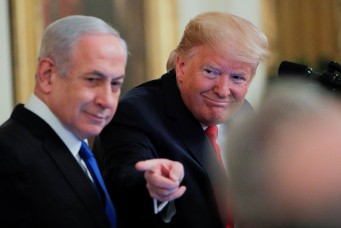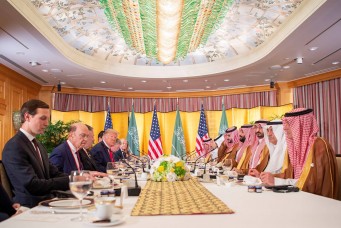The “Deal” of the Century?
The Trump plan imposes Israeli security and economic control over a self-autonomous Palestinian entity.

Palestinians protest President Donald Trump’s long-delayed Mideast peace plan, Gaza City, Jan. 28, 2020. Mohammed Salem/Reuters
The United States announced its new Israel-Palestine peace plan during a ceremony attended by Israeli Prime Minister Benjamin Netanyahu on January 28, 2020. Domestic woes in the U.S. and Israel appeared to determine the timing of the announcement in order to draw attention away from the Democratic Party’s efforts to impeach President Donald Trump, and bolster his chances in the U.S. presidential election this year.
In Israel, the rollout provided an auspicious opportunity for Netanyahu, the Likud party candidate in the upcoming March elections, to divert the public focus from his formal indictment on fraud, bribery, and corruption charges to portrayals of leadership to help his election campaign. His greatest electoral competition, Benny Gantz, was forced to overlook his reservations about the timing of the announcement and visit with Trump a day earlier so as not to appear at odds with U.S. policy just before the Israeli elections in March.
But announcing a proposed settlement in the absence of any Palestinians—and without substantive discussions with them—is a stark departure from more than forty years of U.S. diplomacy of indirect and direct engagement and negotiations with both the Israelis and the Palestinians. It also furthers the perception that the United States is strongly biased toward Israel even at the expense of Palestinian rights.
This exclusion in both the choreography and formulation of the January 28 announcement makes it virtually impossible for Palestinians to even appear to consider the proposed “deal”, even if they wanted to. It raises serious doubts about the proposal’s purpose: Is there a real American-Israeli desire to reach a solution to the Israel-Palestine conflict? Or is the real purpose of this plan to kill any opportunity to start a serious negotiating process, thereby providing cover for Israel to annex more of the occupied Palestinian territories?
Nevertheless, given that international diplomatic practices and political norms seem to be in flux, let us for a moment go beyond the timing and rollout of the new peace initiative (despite the importance of both) to assess it objectively and understand its positive and negative aspects.
A point highlighted as important by the United States and Israel was the U.S. determination to work toward securing economic support in the range of $50 billion for the Palestinians. This is a positive step regardless of whether the source is international or Arab, and irrespective of the fact that national aspirations cannot be bought or sold.
The second suggested positive point is Israel’s commitment to halt settlement expansion for a period of four years. However, this suggestion falls flat when one understands that Israel’s “commitment” under the new deal hinges on the Palestinians agreeing to give up large swathes of land. The proposal to limit settlement expansion is also accompanied by an American commitment not to displace any Israelis or Palestinians from their homes—a move which actually legitimizes the continued presence of existing Israeli settlements in the Palestinian territories in the future.
This new assurance goes even beyond the unilateral guarantees to consolidate most of the large settlement blocs given by former U.S. President George W. Bush to former Israeli Prime Minister Ariel Sharon, which were rejected by the Arab World as well as the international community. In fact, this new commitment is also extremely dangerous because it will inhibit the ability of any future Israeli official to evacuate any of the Israeli settlements in the West Bank.
The third assumed positive is that the initiative included American and Israeli recognition, in principle, of the establishment of a Palestinian state, but this is not new. George W. Bush made a stronger commitment in the context of diplomatic efforts before and after the Annapolis conference in 2008. Former President Bill Clinton, before he left the White House, did the same, albeit describing his position then as a personal opinion since he was about to finish his term in office.
In reality, the “deal” does not envisage a Palestinian state with its citizens exercising their sovereign rights over land and resources.
The two most important considerations in defining a state are land possession and control of decisions and policies within its borders. From this perspective, the American proposal does not grant statehood to the Palestinians, but rather offers limited and continuously conditional autonomy. Under the new proposal, Israel will continue to control points of entry and exit at the borders of the proposed Palestinian state (even those not neighboring Israel). Although the Palestinians will be assigned responsibility for day-to-day law and order, Israel will maintain security sovereignty and the right to intervene as it deems necessary.
Consequently, with the exception of the American financial offer, the assumed positives of the “deal” for the Palestinians are, in fact, misrepresentations.
But, let’s dig deeper. There are four fundamental parameters which have always been paramount in negotiations between the Israelis and the Palestinians.
The first of these is the area of the future Palestinian state. This is predicated on the principles of United Nations (UN) Security Council Resolution No. 242, which inter alia prohibit acquisition of land by force. This means that the restoration of Palestinian land must be carried out on the basis of the June 4, 1967 borders (before the Israeli occupation of the West Bank). In different negotiations, minor exchanges of territory had been proposed in the range of 3 to 6 percent for topographical considerations or for the purpose of unifying villages. The new plan, however, asks Palestinians to concede more than 30 percent of the West Bank.
The issue of Jerusalem, the second parameter, has always held special significance in negotiations because it is important not only to the Palestinians but to the world’s Muslims, Jews, and Christians. Past failed discussions included proposals to redesign and expand the city and differentiate between sovereignty over land and air. Intensive, and difficult negotiations revolved around old Jerusalem and specifically the Dome of the Rock: the Palestinians remain opposed to Israeli sovereignty over this important religious landmark and want it to become the capital of the future Palestinian state. Now, however, the new American-Israeli initiative proposes the establishment of a Palestinian capital in parts of eastern Jerusalem unrelated to the location of religious sites, and beyond the already-built Israeli security barriers and walls.
The third parameter is the return of Palestinian refugees to their historic homeland and the payment of reparations. There is widespread international consensus that the Palestinian refugees are suffering humanitarian consequences that cannot remain ignored and which warrant an urgent resolution. The Palestinians and the Arab World have made a number of concessions in this regard; Arab peace initiatives have affirmed that the solution to the issue of Palestinian refugees must be both “practical” and “just”, thereby implying the right of return or compensation. However, these initiatives have left the question of the number of refugees allowed to return—to Israel, to a future Palestinian state, or to both—up to the negotiations. The number of potential returnees or their compensation have been points of discussion between Palestinian and Israeli leaders at the highest level in the past.
The fourth fundamental parameter to the resolution of the Israeli-Palestinian conflict is security. The basis of the security issue was also outlined in UN Resolution No. 242, which states that, following the end of the Israeli occupation of Palestinian lands, all countries have the right to live in security and safety.
It is strange, then, that after its peace agreements with two of its neighbors—Egypt and Jordan—as well as the signing of the Oslo Accords with the Palestinians, Israel’s security demands have increased. Under the new proposal, Israel seeks to control all Palestinian borders, retain the right to interfere in the future Palestinian entity, and extend its sovereignty to the Jordan Valley. In practical terms, this means codifying the imposition of Israeli security-military control and economic sovereignty on the future entity in the form of full Israeli guardianship.
Although I was not convinced by Israel’s security demands, I at first accepted the idea of regulating Palestinian security forces for a limited period—a similar approach to what the Allies achieved in Germany and Japan after World War II—and what was partially agreed upon with Egypt and Jordan regarding shared border areas. The same model can be applied here despite the admitted inaccuracy of these analogies given that Palestinian security capabilities are much smaller than those of the aforementioned countries.
The new initiative, however, exceeds security needs and appears to reflect a political and ideological projection for the continuation of Israeli control over the West Bank, which directly contradicts the notion of creating a Palestinian state.
I strongly believe that negotiation is the best conflict resolution strategy—in fact, the only one practically available to the Palestinian side. A peaceful solution is the best way to achieve the interests of both parties. Unfortunately, I do not believe that the American-Israeli proposal, dubbed as the “deal of the century”, provides a suitable platform for negotiations to reach a solution satisfying both Israelis and Palestinians. Moreover, the risks inherent to the proposal very much outweigh any potential positives.
I have no objection to negotiations that conclude with the equal exchange of some lands, or which determine the number of Palestinians returning to Israel or Palestine, with others being compensated. Security arrangements can be envisaged to ensure that Israel and Palestine are not subjected to surprise attacks, and can even include implementing some limitations on arms in Palestine for a period of time.
Jerusalem’s ancient holy sites in the Palestinian capital must remain open to all worshipers, including Christians, Jews, and Muslims. Pathways toward Arab normalization with Israel can also be pursued after the end of occupation of Arab lands, provided that the solution fulfills the Palestinians’ legitimate national aspirations of statehood.
What is required now is not submitting to the Trump administration’s proposal simply because it comes from the most powerful country in the world. Nor does it suffice to reject negotiations (that attempt to resolve the conflict) out of anger and frustration. The preferred path forward is decisive political action.
The Palestinians should declare a Palestinian state in the territories that have been under occupation by Israel since 1967. They should form a unified Palestinian government and then call for direct negotiations with Israel under the auspices of the five permanent members of the UN Security Council and on the basis of the 2002 Arab Peace Plan, which includes both bilateral and regional dimensions. They should also litigate Israeli violations of international law in the appropriate international institutions.
Yet, they must be prepared for the possibility that Israel will take further steps to annex territories, destroying any realistic opportunity for a two-state solution. In this case, they should prepare—with greater focus on and support for Israeli Arabs—to pursue a one-state solution with equal rights for all its citizens.
Nabil Fahmy is a former foreign minister of Egypt. He is also Dean Emeritus and Founding Dean of the School of Global Affairs and Public Policy at the American University in Cairo. He served as Egypt’s ambassador to the United States from 1999 to 2008, and as envoy to Japan between 1997 and 1999. On Twitter: @DeanNabilFahmy.
Read MoreSubscribe to Our Newsletter





